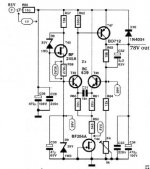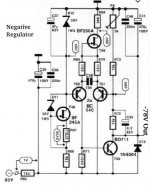In a power amp, it is usually a good idea to run the input and VAS stages at a higher voltage than the ouput stage and to regulate if possible.
Unfortunately, the standard 317/337 regulators are only protected for input voltages up to 37 V. As they float, you can run them at higher voltage but then even a 100 µF cap on the output may kill them on power on.
I have seen and tried other approaches but so far they were either too complex or did not work satisfactorily.
The LM317HV will work up to 47 V, which is only a little better. There is the TL783 that will work up to 125 V which is great.
Unfortunately, there seem to be no negative regulators. The LM337HV will only work to -47 V and it has proved to be impossible to obtain in small quantities in Germany.
I could use two positive regulators, but than I can no longer use a small 2x 9V transformer to add onto the main transformer's voltages. And low current, 2x40 V transformers are also virtually unobtainable.
- Is there a negative HV regulator that I might have overlooked?
- Is there a simple, protected circuit that offers similar performance to a 337?
Thanks in advance,
Eric
Unfortunately, the standard 317/337 regulators are only protected for input voltages up to 37 V. As they float, you can run them at higher voltage but then even a 100 µF cap on the output may kill them on power on.
I have seen and tried other approaches but so far they were either too complex or did not work satisfactorily.
The LM317HV will work up to 47 V, which is only a little better. There is the TL783 that will work up to 125 V which is great.
Unfortunately, there seem to be no negative regulators. The LM337HV will only work to -47 V and it has proved to be impossible to obtain in small quantities in Germany.
I could use two positive regulators, but than I can no longer use a small 2x 9V transformer to add onto the main transformer's voltages. And low current, 2x40 V transformers are also virtually unobtainable.
- Is there a negative HV regulator that I might have overlooked?
- Is there a simple, protected circuit that offers similar performance to a 337?
Thanks in advance,
Eric
Simple is in the eye of the beholder;
There were some other threads on reasonable discrete active regulator topologies, but for the low current demands of the VAS and input diffpair, I think you can probably get away with something really simple:
R-C filter a reference made from a current source and a string of zener diodes, feed it to a PNP emitter follower, put a reasonably large cap at the output.
I don't know of anything simpler.
There were some other threads on reasonable discrete active regulator topologies, but for the low current demands of the VAS and input diffpair, I think you can probably get away with something really simple:
R-C filter a reference made from a current source and a string of zener diodes, feed it to a PNP emitter follower, put a reasonably large cap at the output.
I don't know of anything simpler.
Yeah, that's what has been sitting in the amp I built a couple of years ago. Problem is, the buffer transistor is not protected so it has to be really big so it can survive a discharge from the filter caps. I was looking for something smaller...
Eric
Eric
How can you use a 317/337 on higher voltages and not have it blown as you describe?
I have seen applications using those regulators straight on, only being careful on the input/output being less than 37v, and others using zeners, that apparently protect it more.
Carlos
I have seen applications using those regulators straight on, only being careful on the input/output being less than 37v, and others using zeners, that apparently protect it more.
Carlos
Isn't it possible to put a zener diode across the 317 to take care of the caps charge/discharge?
/Marcus
/Marcus
You can use a LM 337 in a regulator with higher than 37V output, if you protect it for max input-output voltage at startup and in fault conditions, the steady state being safe.. Good examples in the LM317L datasheet from N.S. (and not in others models... why...? ...) The positive designs are easily converted to a negative one with a LM337L for instance...
...) The positive designs are easily converted to a negative one with a LM337L for instance...
😉
http://www.national.com/ds/LM/LM317L.pdf
 ...) The positive designs are easily converted to a negative one with a LM337L for instance...
...) The positive designs are easily converted to a negative one with a LM337L for instance...😉
http://www.national.com/ds/LM/LM317L.pdf
You can use the LM317/LM337 to regulate very high voltages indeed so long as the regulator never sees more than the rated 37V across it from input to output... In fact, thanks to the adjust pin, these regulators can be very versatile indeed. Once you know the regulated output voltage that you want, just subtract 1.25V and then make a reference (perhaps a zener stack with a constant current source) for this voltage ... Then just make sure that Vin will never exceed Vout +/- (whichever is relevant) 37V.
Some time ago, Elektor published a high power amp (Titan 2000 I think) that used discrete HV (about 80V if memory serves) regulators for VAS and driver stages. I'll try to dig the schematic out and scan it if you're interested.
You use a zener
so that the external transistor used as a PASS element doesn't exceed its breakdown voltage.
I cringe at the notion of publishing my HV regulator with the zener string since there were so many complaints about noise (even though it's very much similar to that used in a couple Audio Research pre-amps). The published circuit was a positive regulator, but the same principal can be applied for a negative regulator. Search under HV Regulator and you will get the idea.
Also, consider regulating the ground return. If you can live with a little (some tens of microvolts) switching noise, you can use an opto-coupled feedback loop with a low noise switcher like the LT1533. (Unfortunately these chips are only available in SMT).
so that the external transistor used as a PASS element doesn't exceed its breakdown voltage.
I cringe at the notion of publishing my HV regulator with the zener string since there were so many complaints about noise (even though it's very much similar to that used in a couple Audio Research pre-amps). The published circuit was a positive regulator, but the same principal can be applied for a negative regulator. Search under HV Regulator and you will get the idea.
Also, consider regulating the ground return. If you can live with a little (some tens of microvolts) switching noise, you can use an opto-coupled feedback loop with a low noise switcher like the LT1533. (Unfortunately these chips are only available in SMT).
HV regs from Elektor
Here are the scans for the positive and negative high voltage regs published by Elektor (02/99 French edition), and used in the Titan 2000 Amp. They take 85V unreg, and output 78V. Quite classical design, opamp is replaced with a diff pair, and a zener is used as a reference, itself being fed by a FET CCS (note the 30V zener used in the CCS, to help the Fet to run at such high voltages). Output voltage can be adjusted to your needs by changing the ref. Zener (39V Here) and the voltage divider at the output. Higher currents with another pass bjt.
Here are the scans for the positive and negative high voltage regs published by Elektor (02/99 French edition), and used in the Titan 2000 Amp. They take 85V unreg, and output 78V. Quite classical design, opamp is replaced with a diff pair, and a zener is used as a reference, itself being fed by a FET CCS (note the 30V zener used in the CCS, to help the Fet to run at such high voltages). Output voltage can be adjusted to your needs by changing the ref. Zener (39V Here) and the voltage divider at the output. Higher currents with another pass bjt.
Attachments
Hi!
Anyone know if there is some problem with the national.com?
I can't download the LM317L.PDF as I can't also enter the site.
Thanks
Pedro Martins
Anyone know if there is some problem with the national.com?
I can't download the LM317L.PDF as I can't also enter the site.
Thanks
Pedro Martins
317/337 protection
Why not put a zener from output to input for protection instead of a string of them from the adjusting pin to ground?
Won't these zeners introduce noise at that point?
What happens at power on that may endanger the regulator at higher voltages?
Carlos
Why not put a zener from output to input for protection instead of a string of them from the adjusting pin to ground?
Won't these zeners introduce noise at that point?
What happens at power on that may endanger the regulator at higher voltages?
Carlos
Zener from in to out ...
I think I saw something like that in audio amateur for a (positive) HV supply for a tube preamp.
If I remember correctly it used a TIP-50 NPN as a preregulator, connected as an emitter follower.
The collector to the unregulated input,
the base to the cathode of a zener,
the emitter to input of an LM317,
and the anode of the zener went to the 317's output.
There was also a resistor from unregulated input to base to feed the zener, of course.
The 317's adjust input was connected in series through a string of 5W zeners to ground ...
Seems reasonable, but I don't know how well it worked in practice though.
I think I saw something like that in audio amateur for a (positive) HV supply for a tube preamp.
If I remember correctly it used a TIP-50 NPN as a preregulator, connected as an emitter follower.
The collector to the unregulated input,
the base to the cathode of a zener,
the emitter to input of an LM317,
and the anode of the zener went to the 317's output.
There was also a resistor from unregulated input to base to feed the zener, of course.
The 317's adjust input was connected in series through a string of 5W zeners to ground ...
Seems reasonable, but I don't know how well it worked in practice though.
Here are the scans for the positive and negative high voltage regs published by Elektor (02/99 French edition), and used in the Titan 2000 Amp. They take 85V unreg, and output 78V. Quite classical design, opamp is replaced with a diff pair, and a zener is used as a reference, itself being fed by a FET CCS (note the 30V zener used in the CCS, to help the Fet to run at such high voltages). Output voltage can be adjusted to your needs by changing the ref. Zener (39V Here) and the voltage divider at the output. Higher currents with another pass bjt.
What modifications are needed to provide 88 Volt ?
- Status
- Not open for further replies.
- Home
- Amplifiers
- Power Supplies
- high voltage (>>37 V) negative regulator?

